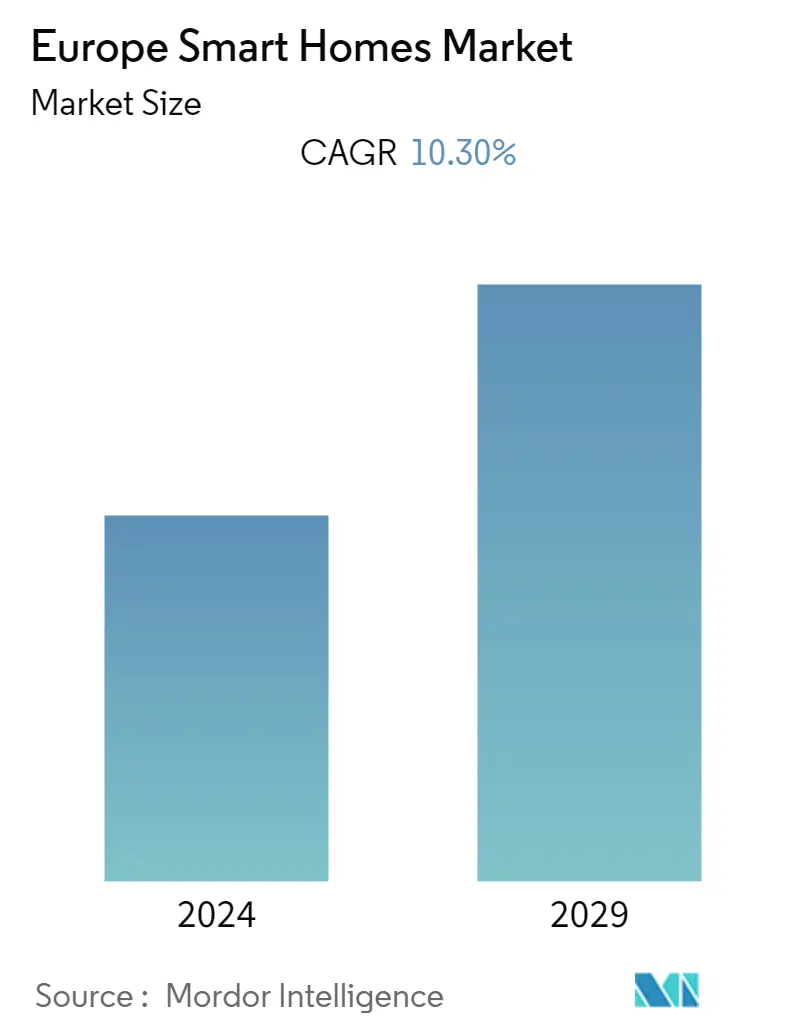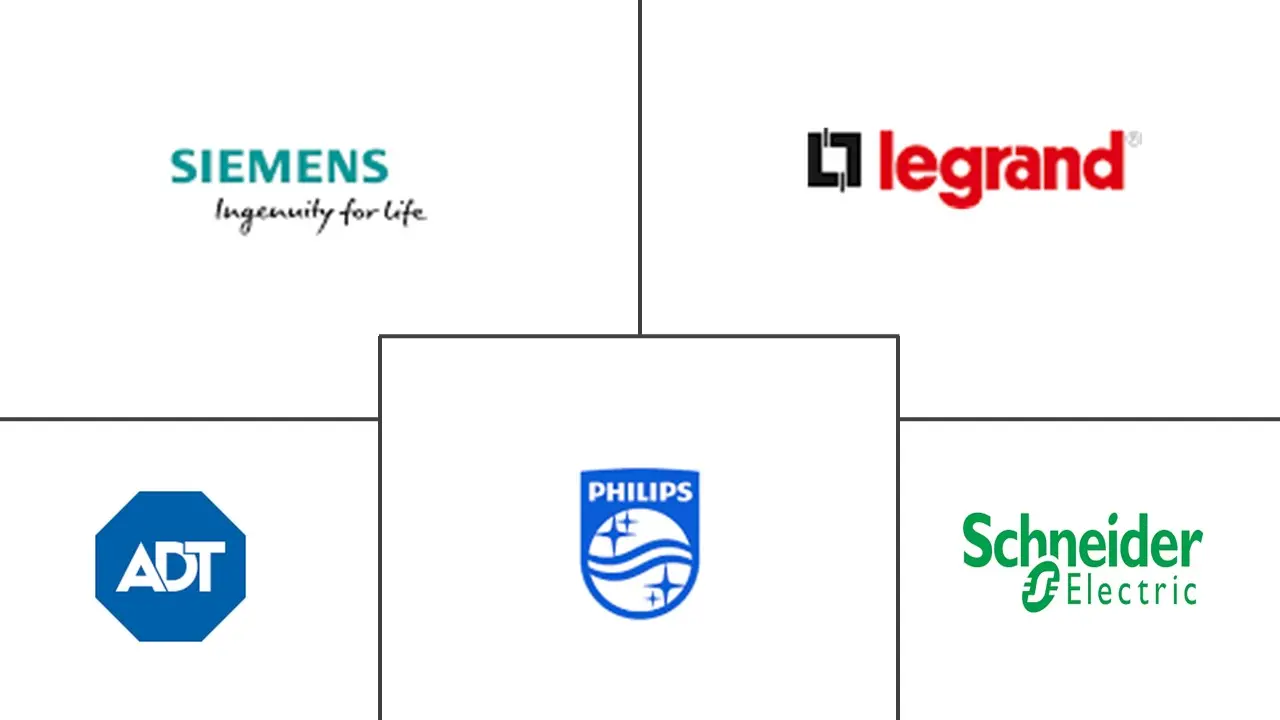Market Size of Europe Smart Homes Industry

| Study Period | 2019 - 2029 |
| Base Year For Estimation | 2023 |
| Forecast Data Period | 2024 - 2029 |
| Historical Data Period | 2019 - 2022 |
| CAGR | 10.30 % |
| Market Concentration | Low |
Major Players
*Disclaimer: Major Players sorted in no particular order |
Europe Smart Home Market Analysis
Europe Smart Homes Market is expected to grow at a CAGR of 10.3% during the forecast period 2021-2026. Investments in smart home technologies are increasing, and so are adoption rates, as consumers start to perceive products, such as voice-activated assistants and smart security systems, as standard household items rather than redundant luxuries.
- Connected energy management devices provide greater functionality. Demand for devices, such as smart lighting systems and smart thermostats, has increased over the past two years, driven by both their money-saving capabilities and their easy-to-use reputation. Hence, such developments are expected to create a need for installation services, thereby impacting the market's growth positively.
- Additionally, smart home devices and services are increasingly playing a significant part in smart city programs. One of the current examples of smart home deployments engaged in driving smart city benefits is the integration of smart thermostats into utility demand management programs.
- The cameras used in the smart home are majorly equipped with security flaws like weak default passwords, unencrypted data, less secured internet gateways, which will become one of the critical factors for adopting a video surveillance camera in the smart home. With the increasing market of smart homes, the demand for secured surveillance cameras would be on the rise.
- Further, smart home devices and services are increasingly playing a significant part in smart city programs. One of the current examples of smart home deployments engaged in driving smart city benefits is the integration of smart thermostats into utility demand management programs.
- However, in the current market scenario, most of the consumers with smart homes view the monthly subscription fees charged by service providers as being too expensive. This is pushing several customers to rely on the DIY model for their smart home devices.
- The market of smart homes in the region has expected that humankind has changed their home designing taste from the COVID-19 pandemic. The consumer's propensity to adopt security solutions is on the rise due to the pandemic scenario and the uncertainty of back into normal life. The aspect of a 'smart home' is looking more practical in the 'new normal' post-COVID-19.
Europe Smart Home Industry Segmentation
The study characterizes the smart home industry based on the installation of key product segments such as Energy Management, Security, Smart Appliances, Lighting solutions, Connectivity products, and security solutions. The study tracks the revenues accrued from the individual product groups as well as the related services solely based on a B2C perspective. The scope of the study is currently focused on key countries such as the United Kingdom, Germany, France, Italy, Netherlands, and other European countries, and key base indicators considered for the study are the number of households, penetration rate, current trends as well as several other key macroeconomic indicators.
| By Product Type | |
| Lighting Products | |
| Energy Management | |
| Security | |
| Connectivity | |
| Energy Management Systems | |
| Home Entertainment and Smart Appliances |
Europe Smart Homes Market Size Summary
The European smart home market is experiencing significant growth, driven by increasing consumer adoption and investments in smart home technologies. As products like voice-activated assistants and smart security systems become standard household items, the demand for connected energy management devices, such as smart lighting systems and thermostats, is on the rise. These devices are favored for their energy-saving capabilities and user-friendly nature, which is expected to boost the market further by creating a need for installation services. Additionally, smart home devices are playing a crucial role in smart city initiatives, with examples like the integration of smart thermostats into utility demand management programs. However, concerns over security flaws in smart home cameras and the high cost of monthly subscription fees are prompting some consumers to opt for DIY solutions.
The market is also influenced by government initiatives aimed at promoting energy efficiency, such as the Green Homes Grant scheme, which offers financial incentives for energy-efficient upgrades. Smart lighting, in particular, is gaining traction due to its potential to reduce energy consumption and costs, making it an attractive option for both residential and commercial applications. Companies like WiZ are expanding their offerings to meet the growing demand for affordable and secure smart lighting solutions. The market is characterized by a diverse range of players, including Siemens AG, Legrand SA, and Philips Lighting, who are investing in innovative and energy-efficient products. The future of the smart home market in Europe is poised for further expansion, driven by product innovation and the increasing adoption of smart devices across various sectors.
Europe Smart Homes Market Size - Table of Contents
-
1. MARKET INSIGHTS
-
1.1 Market Overview
-
1.2 Value Chain / Supply Chain Analysis
-
1.3 Porters 5 Force Analysis
-
1.3.1 Threat of New Entrants
-
1.3.2 Bargaining Power of Buyers
-
1.3.3 Bargaining Power of Suppliers
-
1.3.4 Threat of Substitute Products
-
1.3.5 Intensity of Competitive Rivalry
-
-
1.4 Assessment of the Impact of COVID-19 on the Market
-
-
2. MARKET SEGMENTATION
-
2.1 By Product Type
-
2.1.1 Lighting Products
-
2.1.2 Energy Management
-
2.1.3 Security
-
2.1.4 Connectivity
-
2.1.5 Energy Management Systems
-
2.1.6 Home Entertainment and Smart Appliances
-
-
Europe Smart Homes Market Size FAQs
What is the current Europe Smart Homes Market size?
The Europe Smart Homes Market is projected to register a CAGR of 10.30% during the forecast period (2024-2029)
Who are the key players in Europe Smart Homes Market?
Siemens AG, Legrand SA, ADT Security Services, Philips and Schneider Electric are the major companies operating in the Europe Smart Homes Market.

